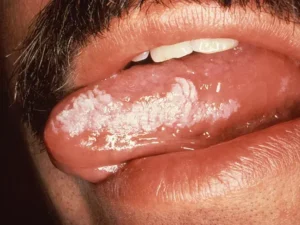What Is Oral Hairy Leukoplakia?
This guide is designed to clearly and simply describe Oral Hairy Leukoplakia (OHL), helping you understand its appearance, what it may mean for your health, and how it is managed. The goal is to demystify this condition and provide you with straightforward, reliable information.
Oral Hairy Leukoplakia appears as white patches that are most commonly found on one or both sides of the tongue. These patches have a unique texture, often described as ridged or corrugated, and they are firmly attached to the tongue’s surface, meaning they cannot be wiped away. While they may look concerning, they are harmless in and of themselves. It is important to know that Oral Hairy Leukoplakia is a benign (non-cancerous) condition and is not considered pre-cancerous.


Podcast:
Learn More About Oral Hairy Leukoplakia
It is also important to know that these white patches are generally not accompanied by redness or inflammation. They are often discovered during a routine dental or medical examination because they may not cause any discomfort.
Now that we have a clear picture of what OHL looks like, let’s explore what causes it to appear.
What Causes OHL? The Role of a Common Virus
Understanding the root cause of OHL is an important first step in managing it. The condition is directly linked to a very common virus that the vast majority of adults already carry in their bodies, often without ever knowing it.
OHL is caused by the reactivation of the Epstein-Barr Virus (EBV).
Most adults around the world have been infected with EBV at some point in their lives, usually during childhood or adolescence. For people with a healthy and fully functioning immune system, the virus typically becomes dormant, or inactive, after the initial infection. In this dormant state, it remains in the body for life but causes no problems or symptoms. OHL develops when something allows this sleeping virus to “wake up” and become active again.
This leads to the next logical question: what causes this dormant virus to become active?
Why Does OHL Appear? Connecting OHL to Your Immune System
The appearance of OHL is often one of the most visible signs that your immune system is weakened. Think of it as an early warning signal from your body, prompting a closer look at your overall health.
The primary reason OHL develops is a weakened immune system, a condition known as immunosuppression. When the body’s immune defenses are lowered, the dormant EBV can reactivate and begin to multiply, leading to the formation of the characteristic white patches on the tongue. For some individuals, the discovery of OHL during a dental or medical exam is the first indication of an undiagnosed underlying condition, such as HIV. This makes identifying and understanding OHL incredibly important for your overall health.
Conditions That Can Weaken the Immune System:
Several health conditions and treatments can lead to immunosuppression. The most common risk factors associated with OHL include:
- HIV infection, particularly when the amount of virus in the blood (viral load) is high and the count of important immune cells (CD4 count) is low.
- Receiving an organ transplant, which requires taking medications that suppress the immune system to prevent organ rejection.
- Undergoing chemotherapy for cancer, as these powerful drugs can also weaken immune function.
- Hematologic malignancies, which are cancers of the blood, such as leukemia or lymphoma.
- Diabetes, although this is considered a less common risk factor.
Knowing the underlying causes of OHL helps explain the most effective approach to managing it, which we will cover next.
How Is Oral Hairy Leukoplakia Managed?
When it comes to managing OHL, it’s helpful to understand that the primary focus is not on “curing” the white patches themselves. Instead, the most effective and important approach is to manage your overall health and the underlying condition that allowed OHL to appear in the first place.
Because the Epstein-Barr virus infection is lifelong, OHL is considered a chronic condition. The patches themselves often do not require any direct treatment unless they are causing symptoms or discomfort.
The single most important management strategy is to effectively treat the underlying condition causing the immunosuppression. By strengthening the immune system, the body can regain control over the Epstein-Barr virus, causing the OHL patches to shrink or disappear on their own.
A key example of this is seen in individuals with HIV. When a person begins effective anti-retroviral therapy, their immune system recovers, which often leads to the complete resolution of the OHL patches. This outcome is the primary goal of management.
While specific topical or oral treatments for the patches are available if they become bothersome, these options are best discussed by partnering with your healthcare team to determine if they are necessary for you. It is important to remember that if direct treatments are stopped while the immune system is still suppressed, the patches are likely to reappear. This reinforces why managing your underlying health condition is the most durable and effective long-term strategy.
With a clear understanding of management, let’s summarize the most important information to take away.
Key Points to Remember
- What It Is: Harmless white, ridged patches on the tongue caused by the reactivation of the common Epstein-Barr virus (EBV). OHL is not cancer.
- What It Means: OHL is an important clinical sign that your immune system may be weakened or suppressed.
- How It Is Managed: The best way to manage OHL is by partnering with your healthcare team to manage the underlying health condition that is affecting your immune system. Improving your overall health is the primary goal.
- What to Expect: The patches can go away completely when your overall health and immune function improve. However, because the EBV infection is lifelong, the patches can sometimes come back.
